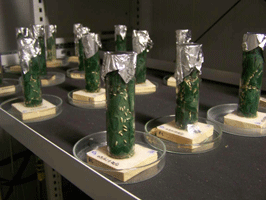Much of the Northern Hemisphere remains ensconced in a cold, snow-covered world, but spring's approach is not far off, bringing with it warm weather (good) and the bugs and bacteria that thrive in it (not so good). Getting ahead of those pests is the job of new masterbatches brought to market by Polyvel and Clariant Masterbatch.
January 26, 2010
Much of the Northern Hemisphere remains ensconced in a cold, snow-covered world, but spring's approach is not far off, bringing with it warm weather (good) and the bugs and bacteria that thrive in it (not so good). Getting ahead of those pests is the job of new masterbatches brought to market by Polyvel and Clariant Masterbatch.
|
Clariant's masterbatch gets tested by termites,and wins. |
From Polyvel (Hammonton, NJ) comes two new series of masterbatches to help processors supply their customers with products on which bacteria cannot find purchase. The first of the developments, the VA-series of masterbatches, contain silver, trichlosan, or proprietary agents that effectively kill microorganisms such as fungus, E. coli and salmonella. These masterbatches are suitable for inclusion in most thermoplastics and can be injection molded and extruded. Since bacteria can emit unpleasant odors, antimicrobials are a method of controlling unwanted scents.
When the source of the smells is not bacteria, Polyvel's ZO-series of odor managing masterbatches help end-product scent improvement.
Clariant Masterbatches, meanwhile, has introduced its CESA-antimicro brand of anti-termite masterbatch for use in compounds based on polyvinyl chloride (PVC). These masterbatches are particularly marketed to processors of wire and cable.
Anti-termite additives are not new, but the Clariant masterbatches are supplied as pellets, enabling processors to avoid the use of insecticidal oils that are applied to PVC pellets or granules before they are processed. Pelletized masterbatches generally are easier to handle than the oils, and have the added benefit that they can be added directly into the extruder. Cable processors in the Middle East already have approved the anti-termite masterbatches, says the supplier, and their effectiveness also has been confirmed in independent-laboratory testing.
"Anti-termite masterbatches can be added during the wire-jacketing process simply by dosing them into the stream of natural material at the extruder feed throat. It is not necessary to maintain a stock of oil-treated PVC along with the untreated compound, so inventory costs are reduced," explains Davor Horvat, head of marketing consumer goods -Southwest Europe, India, Middle East and Africa, at Clariant Masterbatches.
The masterbatches incorporate an EPA (U.S. Environmental Protection Agency)-registered pesticide with a PVC carrier. Clariant also offers a masterbatch formulated with a carrier resin that is compatible with polyolefins. An addition rate of 1% is recommended for both masterbatches. They have been found to be efficient against other insects too, including flies, cockroaches, fleas and bedbugs. —[email protected]
About the Author(s)
You May Also Like



